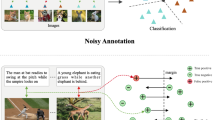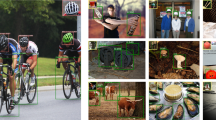Abstract
Automatic annotating images with appropriate multiple tags are very important to image retrieval and image understanding. We can obtain high-dimensional heterogenous visual features from real-world images to describe their various aspects of visual characteristics, such as color, texture, and shape. Different kinds of heterogenous features have different intrinsic discriminative power for image understanding. The selection of groups of discriminative features for certain semantics is hence crucial to make the image understanding more interpretable. This paper proposes an approach, called stable multi-label boosting with structural feature selection (S-MtBFS), for image annotation. S-MtBFS comprises two steps, namely structural feature selection for each label and stable multi-label boosting by curds and whey. In the first step, a (structural) sparse selection model is learned to identify subgroups of homogenous features for the purpose of predicting a certain label. Moreover, a stable method of multi-label boosting with a re-sampling policy is employed in the second step to utilize the correlations among multiple tags. Extensive experiments on public image datasets show that the proposed approach has better and stable performance of multi-label image annotation and leads to a quite interpretable model for image understanding.
Similar content being viewed by others
References
Grangier D, Bengio S. A discriminative kernel-based approach to rank images from text queries. IEEE Trans Patt Anal Mach Intel, 2008, 30: 1371–1384
Chen Y, Wang J Z, Geman D. Image categorization by learning and reasoning with regions. J Mach Learn Res, 2004, 5: 913–939
Maron O, Ratan A L. Multiple-instance learning for natural scene classification. In: Proceedings of the 15th International Conference on Machine Learning, Madison, Wisconsin, USA, 1998. 341–349
Wang C, Yan S, Zhang L, et al. Multi-label sparse coding for automatic image annotation. In: Proceedings of the IEEE Computer Society Conference on Computer Vision and Pattern Recognition, Miami, FL, USA, 2009. 1643–1650
Han Y, Wu F, Jia J, et al. Multi-task sparse discriminant analysis (MTSDA) with overlapping categories. In: Proceedings of the 24th AAAI Conference on Artificial Intelligence, Atlanta, Georgia, USA, 2010. 469–474
Cao L, Luo J, Liang F, et al. Heterogeneous feature machines for visual recognition. In: Proceedings of the 12th IEEE International Conference on Computer Vision, Kyoto, Japan, 2009
Tibshirani R. Regression shrinkage and selection via the lasso. J Royal Stat Soc Ser B, 1996, 58: 267–288
Yuan M, Lin Y. Model selection and estimation in regression with grouped variables. J Royal Stat Soc Ser B, 2006, 68: 49–67
Zou H, Hastie T. Regularization and variable selection via the elastic net. J Royal Stat Soc Ser B, 2005, 67: 301–320
Friedman J, Hastie T, Tibshirani R. A note on the group lasso and a sparse group lasso. Arxiv preprint, arXiv: 1001.0736, 2010
Shen X, Huang H. Grouping pursuit in regression. J Am Stat Assoc, 2010, 105: 727–739
Breiman L, Friedman J. Predicting multivariate responses in multiple linear regression. J Royal Stat Soc Ser B, 1997, 59: 3–54
Hotelling H. Relations between two sets of variates. Biometrika, 1936, 28: 321–377
Kohavi R. A study of cross-validation and bootstrap for accuracy estimation and model selection. In: Proceedings of the International Joint Conference on Artificial Intelligence, Montréal, Québec, Canada, 1995. 1137–1145
Miller R G. The jackknife—a review. Biometrika, 1974, 61: 1–15
Efron B. Bootstrap methods: another look at the jackknife. Ann Stat, 1979, 7: 1–26
Beck A, Teboulle M. A fast iterative shrinkage-thresholding algorithm for linear inverse problems. SIAM J Imag Sci, 2009, 2: 183–202
Wu F, Han Y, Tian Q, et al. Multi-label boosting for image annotation by structural grouping sparsity. In: Proceedings of the ACM International Conference on Multimedia, Firenze, Italy, 2010. 15–24
Bishop C M. Pattern Recognition and Machine Learning, Volume 4. New York: Springer, 2006
Bousquet O, Elisseeff A. Stability and generalization. J Mach Learn Res, 2002, 2: 499–526
Zhou Z H, Zhang M L. Multi-instance multi-label learning with application to scene classification. In: Proceedings of Conference on Neural Information Processing Systems, Vancouver, British Columbia, Canada, 2007
Chua T S, Tang J, Hong R, et al. Nus-wide: A real-world web image database from National University of Singapore. In: Proceedings of the ACM International Conference on Image and Video Retrieval, Island of Santorini, Greece, 2009. 1–9
Lewis D D. Evaluating text categorization. In: Proceedings of Speech and Natural Language Workshop, Pacific Grove, California, USA, 1991. 312–318
Ji S, Tang L, Yu S, et al. Extracting shared subspace for multi-label classification. In: Proceedings of the ACM SIGKDD International Conference on Knowledge Discovery and Data Mining, Las Vegas, Nevada, USA, 2008. 381–389
Author information
Authors and Affiliations
Corresponding author
Additional information
ZHUANG YueTing was born in 1965. He received the B.S., M.S., and Ph.D. degrees from Zhejiang University, Hangzhou, China in 1986, 1989, and 1998, respectively. Currently, he is a Professor and Ph.D. Supervisor with the College of Computer Science, Zhejiang University. His current research interests include multimedia databases, artificial intelligence, and video-based animation.
WU Fei was born in 1973. He received the B.S. degree from Lanzhou University, Lanzhou, Gansu, China, the M.S. degree from Macao University, Taipa, Macau, and the Ph.D. degree from Zhejiang University, Hangzhou, China. He is currently a Professor with the College of Computer Science, Zhejiang University. His current research interests include multimedia analysis, retrieval, statistic learning, and pattern recognition.
HAN YaHong was born in 1977. He received the B.S. degree from Zhengzhou University, Zhengzhou, Henan, China in 2000, and the M.S. degree from Hohai University, Nanjing, Jiangsu, China in 2003. He is currently pursuing the Ph.D. degree from the College of Computer Science, Zhejiang University, Hangzhou, China. His current research interests include multimedia analysis, retrieval, and machine learning.
Electronic supplementary material
Supplementary material, approximately 9.71 MB.
Rights and permissions
About this article
Cite this article
Zhuang, Y., Han, Y., Wu, F. et al. Stable multi-label boosting for image annotation with structural feature selection. Sci. China Inf. Sci. 54, 2508–2521 (2011). https://doi.org/10.1007/s11432-011-4483-5
Received:
Accepted:
Published:
Issue Date:
DOI: https://doi.org/10.1007/s11432-011-4483-5




